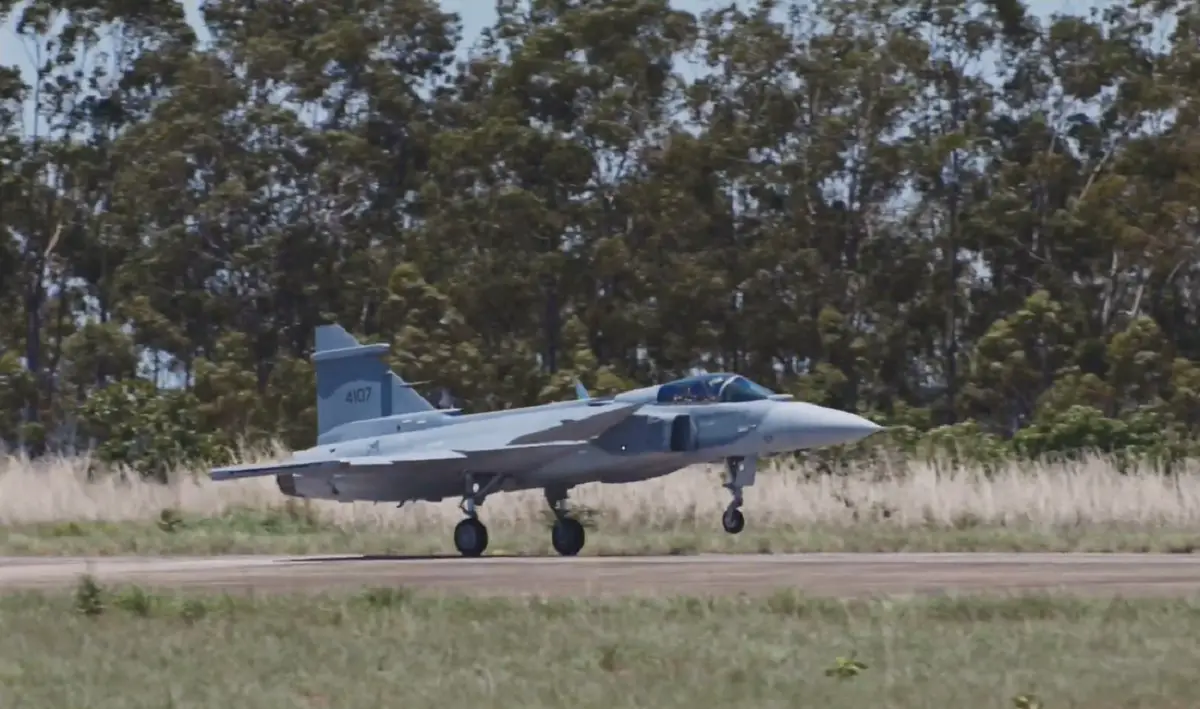The fighter jet, with registration FAB 4107, landed at Anápolis Air Base (BAAN) on Friday morning, December 15. Manufactured by Saab, the aircraft arrived in Brazil on December 11 via the Port of Navegantes, Santa Catarina. After preparations at the airport in the same city, including the assembly of separated systems like the ejection seat, the plane undergoes ground tests before being ready for flight. The aircraft departed from Navegantes for a 1.5-hour journey to Anápolis Air Base, piloted by Lieutenant Colonel Aviator Abdon de Rezende Vasconcelos, a test pilot from the Brazilian Air Force’s Research and Flight Testing Institute (IPEV). The 1st Air Defense Group at Anápolis Air Base, operating Gripen fighters, now has seven aircraft, including the 4100 test aircraft conducting trials from the Gripen Flight Test Center at Embraer in Gavião Peixoto (SP) since 2020.
The Saab JAS 39 Gripen is a light single-engine supersonic multirole fighter aircraft manufactured by the Swedish aerospace and defence company Saab AB. The Gripen has a delta wing and canard configuration with relaxed stability design and fly-by-wire flight controls. Later aircraft are fully NATO interoperable. As of 2020, more than 271 Gripens of all models, A–F, have been delivered. A major redesign of the Gripen series, previously referred to as Gripen NG (Next Generation) or Super JAS, now designated JAS 39E/F Gripen began deliveries to the Swedish Air Force and Brazilian Air Force in 2019. Changes from the JAS C to JAS E include a larger fuselage, a more powerful engine, an increased weapons payload capability, and new cockpit, avionics architecture, electronic warfare system and other improvements.

The Brazilian Air Force initially planned to procure at least 36 and possibly up to 120 later,[233][234] to replace its Northrop F?5EM and Dassault Mirage 2000C aircraft. President Dilma Rousseff announced the Gripen NG’s selection on 18 December 2013. Key factors were domestic manufacturing opportunities, full Transfer of Technology (ToT), participation in its development, and potential exports to Africa, Asia and Latin America;[109][241] Argentina and Ecuador are interested in procuring Gripens via Brazil, and Mexico is considered an export target.[243] Another factor was the distrust of the US due to the NSA surveillance scandal. The Gripen is not immune to foreign pressure: the UK may use their 30% component percentage in the Gripen to veto an Argentinian sale over the Falkland Islands dispute; thus Argentina is considering other fighters instead.
On 24 October 2014, Brazil and Sweden signed a 39.3 billion SEK (US$5.44 bn, R$13 bn) contract for 28 Gripen E (single-seat version) and eight Gripen F (dual-seat version) fighters for delivery from 2019 to 2024 and maintained until 2050; the Swedish government will provide a subsidized 25-year, 2.19% interest rate loan for the buy.[248] At least 15 aircraft are to be assembled in Brazil, Brazilian companies shall be involved in its production; Gripen Fs are to be delivered later. An almost US$1 billion price increase since selection is due to developments requested by Brazil, such as the “Wide Area Display” (WAD), a panoramic 19 by 8?inches touchscreen display. The Brazilian Navy is interested in the Gripen Maritime to replace its Douglas A-4KU Skyhawk carrier-based fighters. In 2015, Brazil and Sweden finalised the deal to develop the Gripen F, designated F-39 by Brazil.












